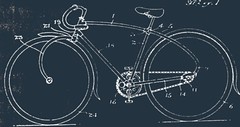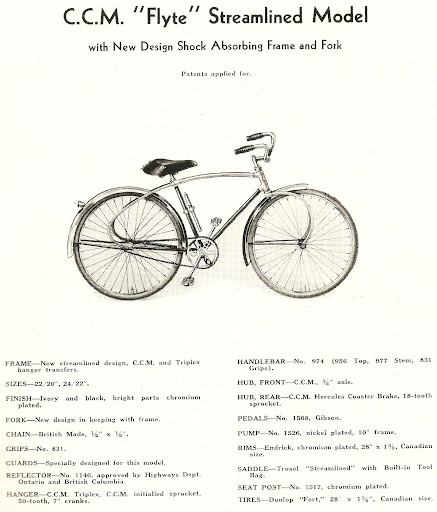The Holy Grail
Introduced in 1936 the CCM Flyte would become the most sought after of CCM's numerous bicycle lines. Designed by company employee Harvey Peace it was the only bicycle design for which Canada Cycle & Motor Ltd. actually sought a patent.
The Patent Application
The principal objects of the invention are to provide a bicycle of an unusual novel and attractive appearance which will have a distinct appeal to the eye in conformance with the line adopted in the streamlining of vechicles and further, to utilize the treamline effect of design to accomplish a very distinct improvement in the riding qualities of the bicycle to the effect the absorbing of road shocks and further, to provide a very desirable form of bicycle having a distinctly novel appeal. The principal features of the invention consist in the novel construction of the main frame whereby the upper bar is curved to meet the rear ends of the lower fork and to form a continuous part therewith and the front forks are curved downwardly with their lower ends bent rearwardly to form a resilient front support corresponding in part with the resilient rear fork.
In the manufacture of bicycles, it has been the practice for many years to construct the frame in accordance with a "standard" pattern which in side elevation is substantially diamond-shape or of a rhomboid formation with the rear forks extending substantially horizonally from the crank bracket and mating the rear braces or upper forks at an acute angle where the axle of the wheel is mounbted in slotted brackets and the front forks of said "standard" type of bicycles slope straight down from the head or front end of the frame having a slight curve forward for the castor effect. In the "standard" type of bicycle, the frame and forks are perfectly rigid and the shocks and vibrations of road travel are carried directly through the frame and transmitted to the rider. It is the dual purpose of this invention to devise a bicycle that will be easier to ride, its construction being such as to eliminate most of the minor vibrations and many of the major ones, or at least to greatly soften the transmission of such to the rider and further, to provide a bicycle which will appeal to the eye as conforming to present day standards of streamlining effects. In carrying these ideas into practice, I have contsructed a bicycle as shown in the accompanying drawings.
Harvey W. Peace
Assignor to Canada Cycle and Motor Ltd.

The patent filed on October 23, 1935 and designated Patent No. 358849 was granted on June 30, 1936 and outlined a bicycle CCM claimed was both novel in design and practical in its ability to absorb the shocks and vibrations of the road. Said to feature the "New Design Shock Absorbing Frame and Fork," the Flyte, available with either a 22" or 20" frame, was introduced by CCM in 1936 and produced until 1940.

Company claims to the contrary the CCM Flyte was neither a revolutionary nor an entirely new design. The Schwinn company, a company with which Canada Cycle & Motor enjoyed a close relationship, had introduced the "Streamline Aerocycle" in 1934 and as noted Flyte collector Ken Martin points out (www.ccmflyte.com) the curved seatstays on the Fyte were not the first of its type since the same design could be found on the 1934 Monarck "Silver King."
While CCM marketed the Flyte as being stylish as well as functional, the fact remained that the model never became a big seller. As Martin points out, the company's decision not to resume production after the war indicates that the Flyte was not in great demand, unlike the CCM Motorbike model which remained a part of the company's product line for fifty years.
Retailing at $45.00 (as opposed to the CCM Roadster at $28.95), some maintained the Flyte was simply too expensive for a country mired in the depths of a depression. Longtime CCM dealer Tom Marshall disagrees. With the sale of motor cars slumping badly during the Depression, Marshall counters that the hard times were actually a boon to bicycle sales. The first year of the Flyte in 1936 saw bicycle production in Canada increase by 30% over the previous year and production continued to climb steadily during the next four years.
Furthermore, while it carried a considerable price tag, at the time the Flyte was still less expensive than the CCM Flyer ($80.00) and its delivery model ($55.00), both of which continued to sell during the Depression.
"That leaves design, which was probably too radical for the marketplace," maintains Marshall. "Had they simply streamlined a Motorbike without incorporating the cushioned stays and forks, it likely would have sold well, despite the price increase. It did for Schwinn and other U.S. companies."
Whatever the reason, the limited production numbers for the CCM Flyte ensured its future rarity, thus turning it into the Holy Grail for CCM bicycle collectors.

Harvey Peace, who had designed the Flyte, was also instrumental in the design of CCM's tube skate (1929) and the CCM Bike-Wagon (1932).
![]() A forty year veteran of CCM, Peace lived to see only one year of his bicycle's production, passing away, as he did, on December 12, 1936 at the age of 56. A champion bicycle racer in his youth, Peace was a popular member of the Weston community and at the time his funeral was said to be among the largest the town had ever had.
A forty year veteran of CCM, Peace lived to see only one year of his bicycle's production, passing away, as he did, on December 12, 1936 at the age of 56. A champion bicycle racer in his youth, Peace was a popular member of the Weston community and at the time his funeral was said to be among the largest the town had ever had.
"Friends and acquaintances from all walks of life gathered to do him tribute and the beautiful and numerous floral tributes were centred with a beautiful wreath from the CCM. This unusual floral piece was in the form of the CCM trademark finished in rare flowers, including orchids. ("Many Pay Tribute to Harvey W. Peace," VIM, Vol.24, No. 1, 1937, p.19)
In the end the true legacy of Harvey W. Peace was to be found in a bicycle design that would become the ultimate desire of CCM collectors around the world.




